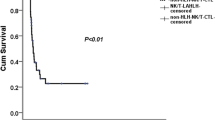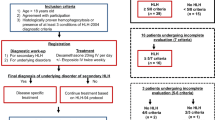Abstract
Extranodal natural killer (NK)/T cell lymphoma-associated hemophagocytic syndrome (HPS) (NK/T-LAHS) is a heterogeneous and life-threatening disease, which warrants investigation of its risk factors and clinical features. We retrospectively analyzed the clinical records of 202 patients with extranodal NK/T cell lymphoma and compared the characteristics and survival of extranodal NK/T cell lymphoma patients with and without HPS. The cumulative incidence of NK/T-LAHS was 11.4 % (23/202). In a multivariate logistic regression model, younger age (p = 0.012), bone marrow involvement (p = 0.012), and reduced serum albumin (p < 0.001) were independent risk factors for developing HPS in patients with extranodal NK/T cell lymphoma. The survival of extranodal NK/T cell lymphoma patients was aggravated when complicated with HPS, with an overall 2-year survival of 72.1 and 30.4 %, respectively (p < 0.001). Six patients with HPS onset at lymphoma diagnosis tended to have a poor performance status (p = 0.040), while the rate of elevated bilirubin was significantly higher in 17 patients with HPS onset at lymphoma relapse (p = 0.045). After HPS onset, treatment response was poor (response rate, 17.4 %) and survival was dismal with a median of 26 days. Univariate analysis showed that patients with lactate dehydrogenase >1000 U/L (p = 0.048) and disseminated intravascular coagulation (p = 0.004) had shorter survival time. Extranodal NK/T cell lymphoma was frequently complicated with HPS, and survival was discouraging in this circumstance. Intensive chemotherapy regimens including l-asparaginase or pegaspargase and allogeneic stem cell transplantation should be investigated.

Similar content being viewed by others
References
Chan JK, Ng CS (1989) Malignant lymphoma, natural killer cells and hemophagocytic syndrome. Pathology 21:154–155
Okuda T, Sakamoto S, Deguchi T et al (1991) Hemophagocytic syndrome associated with aggressive natural killer cell leukemia. Am J Hematol 38:321–323
Wong KF, Chan JK, Ng CS, Chu YC, Li LP, Chan CH (1992) Large cell lymphoma with initial presentation in the bone marrow. Hematol Oncol 10:261–271
Filipovich AH (2009) Hemophagocytic lymphohistiocytosis (HLH) and related disorders. Hematology Am Soc Hematol Educ Program 1:127–131
Kumakura S (2005) Hemophagocytic syndrome. Intern Med 44:278–280
Wong KF, Chan JK (1992) Reactive hemophagocytic syndrome-a clinicopathologic study of 40 patients in an Oriental population. Am J Med 93:177–180
Szyper-Kravitz M (2009) The hemophagocytic syndrome/macrophage activation syndrome: a final common pathway of a cytokine storm. Isr Med Assoc J 11:633–634
Henter JI, Horne A, Arico M et al (2007) HLH-2004: diagnostic and therapeutic guidelines for hemophagocytic lymphohistiocytosis. Pediatr Blood Cancer 48:124–131
Ramos-Casals M, Brito-Zeron P, Lopez-Guillermo A, Khamashta MA, Bosch X (2014) Adult haemophagocytic syndrome. Lancet 383:1503–1516
Lehmberg K, Nichols KE, Henter JI et al (2015) Consensus recommendations for the diagnosis and management of hemophagocytic lymphohistiocytosis associated with malignancies. Haematologica 100:997–1004
Kogawa K, Sato H, Asano T et al (2014) Prognostic factors of Epstein-Barr virus-associated hemophagocytic lymphohistiocytosis in children: report of the Japan Histiocytosis study group. Pediatr Blood Cancer 61:1257–1262
Goudarzipour K, Kajiyazdi M, Mahdaviyani A (2013) Epstein-Barr virus-induced hemophagocytic lymphohistio-cytosis. Int J Hematol Oncol Stem Cell Res 7:42–45
Ménard F, Besson C, Rincé P et al (2008) Hodgkin lymphoma–associated Hemophagocytic syndrome: a disorder strongly correlated with Epstein-Barr virus. Clin Infect Dis 47:53–54
Chubachi A, Miura AB (1994) Lymphoma-associated hemophagocytic syndrome in adults: a review of the literature [in Japanese]. Jpn J Clin Hematol 35:837–845
Li J, Wang Q, Zheng W et al (2014) Hemophagocytic lymphohistiocytosis: clinical analysis of 103 adults patients. Medicine (Baltimore) 93:100–105
Yu JT, Wang CY, Yang Y et al (2013) Lymphoma-associate d hemophagocytic lymphohistiocytosis: experience in adults from a single institution. Ann Hematol 92:1529–1536
Sun J, Yang Q, Lu Z et al (2012) Distribution of lymphoid neoplasms in China: analysis of 4,638 cases according to the World Health Organization classification. Am J ClinPathol 138:429–434
Lim ST, Hee SW, Quek R et al (2008) Comparative analysis of extra-nodal NK/T-cell lymphoma and peripheral T-cell lymphoma: significant differences in clinical characteristics and prognosis. Eur J Haematol 80:55–60
Swerdlow SH, Campo E, Harris NL et al (2008) WHO Classification of Tumours of Haematopoietic and Lymphoid Tissues (ed 4th). Lyon, France
Lin N-j, Yu-qin S, Zheng W et al (2015) Lymphoma-associated hemophagocytic syndrome: an analysis of clinical features and survival of 27 cases from a single center in China. Tumor 35:197–203
Han L, Li L, Wu J et al (2014) Clinical features and treatment of natural killer/T cell lymphoma associated with hemophagocytic syndrome: comparison with other T cell lymphoma associated with hemophagocytic syndrome. Leuk Lymphoma 55:2048–2055
Takahashi N, Miura I, Chubachi A, Miura AB, Nakamura S (2001) A clinicopathological study of 20 patients with T/Natural Killer (NK)-cell lymphoma–associated hemophagocytic syndrome with special reference to nasal and nasal-type NK/T-cell lymphoma. Int J Hematol 74:303–308
Robbins KT, Fuller LM, Vlasak M et al (1985) Primary lymphomas of the nasal cavity and paranasal sinuses. Cancer 56:814–819
Oken MM, Creech RH, Tormey DC et al (1982) Toxicity and response criteria of the Eastern Cooperative Oncology Group. Am J Clin Oncol 5:649–655
Shipp MA (1993) A predictive model for aggressive non-Hodgkin’s lymphoma. The international non-hodgkin’s lymphoma prognostic factors project. N Engl J Med 329:987–994
Cheson BD, Pfstner B, Juweid ME et al (2007) Revised response criteria for malignant lymphoma. J Clin Oncol 25:579–586
Sano H, Kobayashi R, Tanaka J et al (2014) Risk factor analysis of non-Hodgkin lymphoma-associated haemophagocytic syndromes: a multicentre study. Br J Haematol 165:782–792
Tong H, Ren Y, Liu H et al (2008) Clinical characteristics of T-cell lymphoma associated with hemophagocytic syndrome: Comparison of T-cell lymphoma with and without hemophagocytic syndrome. Leuk Lymphoma 49:81–87
Han AR, Lee HR, Park BB et al (2007) Lymphoma-associated hemophagocytic syndrome: clinical features and treatment outcome. Ann Hematol 86:493–498
Yeh YM, Chang KC, Chen YP et al (2010) Large B cell lymphoma presenting initially in bone marrow, liver and spleen: an aggressive entity associated frequently with haemophagocytic syndrome. Histopathology 57:785–795
Colotta F, Allavena P, Sica A, Garlanda C, Mantovani A (2009) Cancer-related inflammation, the seventh hallmark of cancer: links to genetic instability. Carcinogenesis 30:1073–1081
Andersson C, Lonnroth C, Moldawer LL, Ternell M, Lundholm K (1990) Increased degradation of albumin in cancer is not due to conformational or chemical modifications in the albumin molecule. Journal of Surgical Research 49:23–29
Bi XW, Wang L, Zhang WW et al (2016) The pretreatment albumin to globulin ratio predicts survival in patients with natural killer/T-cell lymphoma. Peer J 4:e1742
de Kerguenec C, Hillaire S, Molinié V et al (2001) Hepatic manifestations of hemophagocytic syndrome: a study of 30 cases. Am J Gastroenterol 96:852–857
Chauchet A, Michallet AS, Berger F et al (2012) Complete remission after first-line radio-chemotherapy as predictor of survival in extranodal NK/T-cell lymphoma. J Hematol Oncol 5:27
Cheung MM, Chan JK, Lau WH, Foo W, Chan PT, Ng CS (1998) Primary non-Hodgkin’s lymphoma of the nose and nasopharynx: clinical features, tumor immunophenotype, and treatment outcome in 113 patients. J Clin Oncol 16:70–77
Henter JI, Samuelsson-Horne A, Aricò M, Egeler RM, Elinder G, Filipovich AH (2002) Treatment of hemophagocytic lymphohistiocytosis with HLH-94 immunochemotherapy and bone marrow transplantation. Blood 100:2367–2373
Reyes VE Jr, Al-Saleem T, Robu VG, Smith MR (2010) Extra nodal NK/T-cell lymphoma nasal type: efficacy of pegaspargase. Report of two patients from the United Sates and review of literature. Leuk Res 34:e50–54
Yanagiya N, Takahashi N, Nakae H, Kume M, Chubachi A, Miura I (2002) Plasma exchange and continuous hemodiafiltration as an initial treatment for diffuse large B-cell lymphoma associated hemophagocytic syndrome. Rinsho Ketsueki 43:35–40
Machaczka M, Nahi H, Karbach H, Klimkowska M, Hägglund H (2012) Successful treatment of recurrent malignancy-associated hemophagocytic lymphohistiocytosis with a modified HLH-94 immunochemotherapy and allogeneic stem cell transplantation. Med Oncol 29:1231–1236
Yan Z, Xiao-nan H (2013) 23 cases of extranodal NK/T-cell lymphoma associated with reactive haemophagocytic syndrome: a retrospective study. Chin J Cancer Prev Treat 20:1672–1675
Na II, Kang HJ, Park YH et al (2007) Prognostic factors for classifying extranodal NK/T cell lymphoma, nasal type, as lymphoid neoplasia. Eur J Haematol 79:1–7
Yamazaki H, Kondo T, Tatsumi G et al (2015) Successful treatment with recombinant thrombomodulin for disseminated intravascular coagulation complicated with hemophagocytic syndrome. Rinsho Ketsueki 56:312–316
Uni M, Yoshimi A, Maki H et al (2013) Successful treatment with recombinant thrombomodulin for B-cell lymphoma-associated hemophagocytic syndrome complicated by disseminated intravascular coagulation. Int J Clin Exp Pathol 6:1190–1194
Author information
Authors and Affiliations
Corresponding author
Ethics declarations
Ethical approval
All procedures performed in studies involving human participants were in accordance with the ethical standards of the institutional and national research committee and with the 1964 Helsinki Declaration and its later amendments or comparable ethical standards.
Conflict of interest
The authors declare that they have no conflict of interest.
Rights and permissions
About this article
Cite this article
Jia, J., Song, Y., Lin, N. et al. Clinical features and survival of extranodal natural killer/T cell lymphoma with and without hemophagocytic syndrome. Ann Hematol 95, 2023–2031 (2016). https://doi.org/10.1007/s00277-016-2805-9
Received:
Accepted:
Published:
Issue Date:
DOI: https://doi.org/10.1007/s00277-016-2805-9




